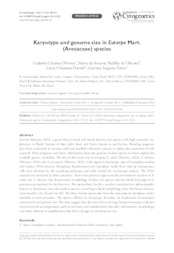Karyotype and genome size in Euterpe Mart. (Arecaceae) species.
Karyotype and genome size in Euterpe Mart. (Arecaceae) species.
Author(s): OLIVEIRA, L. C.; OLIVEIRA, M. do S. P. de; DAVIDE, L. C.; TORRES, G. A.
Summary: Euterpe (Martius, 1823), a genus from Central and South America, has species with high economic importance in Brazil, because of their palm heart and fruits, known as açaí berries. Breeding programs have been conducted to increase yield and establish cultivation systems to replace the extraction of wild material. These programs need basic information about the genome of these species to better explore the available genetic variability. The aim of this study was to compare E. edulis (Martius, 1824), E. oleracea (Martius, 1824) and E. precatoria (Martius, 1842), with regard to karyotype, type of interphase nucleus and nuclear DNA amount. Metaphase chromosomes and interphase nuclei from root tip meristematic cells were obtained by the squashing technique and solid stained for microscope analysis. The DNA amount was estimated by flow cytometry. There were previous reports on the chromosome number of E. edulis and E. oleracea, but chromosome morphology of these two species and the whole karyotype of E. precatoria are reported for the first time. The species have 2n=36, a number considered as a pleisomorphic feature in Arecoideae since the modern species, according to floral morphology, have the lowest chromosome number (2n=28 and 2n=30). The three Euterpe species also have the same type of interphase nuclei, classified as semi-reticulate. The species differed on karyotypic formulas, on localization of secondary constriction and genome size. The data suggest that the main forces driving Euterpe karyotype evolution were structural rearrangements, such as inversions and translocations that alter chromosome morphology, and either deletion or amplification that led to changes in chromosome size.
Publication year: 2016
Types of publication: Journal article
Unit: Embrapa Eastern Amazon
Keywords: Açaí, Citometria de fluxo, Evolução cromossômica, Genoma
Observation
Some of Embrapa's publications are published as ePub files. To read them, use or download one of the following free software options to your computer or mobile device. Android: Google Play Books; IOS: iBooks; Windows and Linux: Calibre.
Access other publications
Access the Agricultural Research Database (BDPA) to consult Embrapa's full library collection and records.
Visit Embrapa Bookstore to purchase books and other publications sold by Embrapa.

